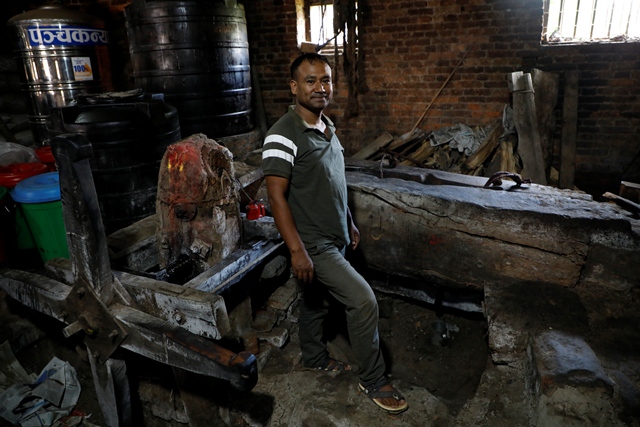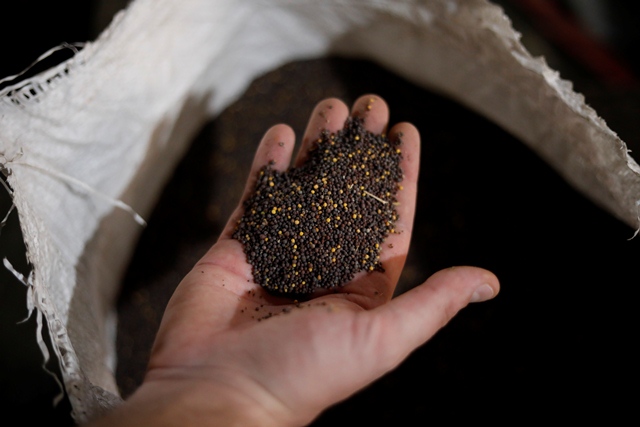Food
Mustard oil, once king of the kitchen, sees fewer buyers
For a small number of mills in and around Kathmandu, mustard oil is both tradition and livelihood—and a secret language in danger of vanishing.
Thomas Heaton
Fashioned from forged steel and two hewed wooden trunks, an ancient-looking apparatus dominates this dark and diminutive space. The walls, sooty with smoke and oil residue, absorb what little light enters its mail slot windows. At 3am every day, a team puts the medieval rig into action, slowly forcing the wooden beams together, using their weight to apply enough pressure to the contraption’s giant wooden crank. From between the wooden beams, a sack of mustard seeds weeps dark crimson oil.
While mustard oil is commonplace in Nepali kitchens and traditions, traditional mills such as this one have been slowly disappearing over the decades. But here at Khol Ko Tel, just west of Basantapur Durbar Square, the traditional process of producing tori ko tel has not changed for the past 45-odd years.
Mustard oil has long been an institutional part of the culture in Nepal, especially within communities of the Valley. Once part of a waste-free and quasi-circular economy that fed itself through mostly cashless transactions, an influx of imported vegetable oils and flashy marketing campaigns has led to a decline in the number of mills, while a rapidly urbanising Valley has led to the country’s self-reliant production dying out.
But Khol Ko Tel has continued, despite market pressures and a declining sense of necessity. That’s thanks to customers like Gauri Dahal, who still frequents the storefront. Dahal, despite living on the other side of town in Jorpati, has been buying her mustard oil from the mill for nearly 20 years now. Passing large empty bottles to mill owner Kiran Manandhar, Dahal plans to take home 11 litres.
“The oil you get in stores is not as aromatic as this mustard oil,” says Dahal. “There are many mills around me, but I prefer it here because it’s tastier—a few other people from my neighbourhood come here too.” She buys an extra bottle for her daughter-in-law, for good measure.
Manandhar relies on customers like Dahal. He doesn’t advertise, and it’s impossible to price competitively and he doesn’t cut corners. Loyalty and word-of-mouth are what keep him afloat. “It’s not profitable, really. I just want to keep the tradition alive,” says Manandhar. “This is not just a business though; it’s part of our identity.”
Manandhars have long been connected to the mustard oil industry, eking out livelihoods for generations by providing oil to the communities in which they live. The oil is used for more than just cookery—it’s slathered on skin or dabbed in ears for remedial and antidotal purposes. Its historical and cultural importance could be akin to olive oil for Italians.
“Wherever there’s Newar people, or Manandhars, there’s mustard oil,” he says.
But the introduction of imported, and intensely manufactured and marketed, mustard oils that go for a cheaper price has affected their trade. “It’s not just foreign oil. It’s other kinds of oil too,” says Manandhar. Soybean, sunflower and vegetable oils have hurt him and his counterparts. So much so, people have lost sight of what traditional roasted mustard oil really looks like, he says.

“People have come to think this oil isn’t healthy,” says Manandhar, referring to his inky black roasted mustard oil. This has filtered down into communities that shopped within themselves and kept its own businesses afloat.
Basantapur once boasted 10 mills dedicated to lubricating and flavouring the community’s food, but there are just three now—Manandhar’s older brother owns one of them. Further south in Khokana, an area synonymous with its oil, the numbers have also faltered. Sikali Multipurpose Cooperative is one of just two left in the township.
“Twenty to 30 years ago, four mills were run by the community. There are two now, with us being one. The other is a private mill,” says Sikali Multipurpose Cooperative mill manager Siddhi Sadan.
At Sikali Multipurpose, like other traditional mills, there’s one ingredient and the process is simple. Seeds are crushed, then poured onto a large cast-iron plate atop a log fire. Roasted for 30 minutes before being placed into the milling machine, they are crushed until all moisture is harvested. The byproduct of the process, the caked solids, is called peena and is sold as animal feed or fertiliser.
Unlike Basantapur, Khokana is linked inextricably with mustard oil, which is the best in the Valley. Manandhar says he doesn’t know why, considering he makes his oil the exact same way, and probably with the same seeds.
“I’ve not compared the quality, but I use the same technology. I think the brand of Khokana is so strong that it sells a lot,” says Manandhar.
The mustard seeds the Khokana cooperative uses hail from either western Tarai or further afield. They use three types of seeds for their oil: yellow, ‘red’, and black. While red ones are not too different from the black ones, they differentiate them because of small red spots. While in years past there might have been people coming in with homegrown seeds for processing, it doesn’t really happen anymore, and much of the oil pressed in Nepal comes through India, and could hail from as far as Ukraine, France, Australia, Belgium, or Canada, says Maharjan. In fact, the country imported more than 18,000 tonnes of mustard seed in the 2018/19 financial year, according to the Department of Customs.
Manandhar of Khol Ko Tel says he tries to use Nepali seeds as much as he can. “But if we don’t find it, we depend on imports,” he says. He has been using imported seeds for the past 15 years, but always tries to use local seeds when it comes to the most important time of the year: Dashain. The reality is, however, the supply is sporadic and people hardly bring their own mustard seeds anymore. In the past, it was common practice for people to use community-based mills to process their mustard seed harvest.
While he struggles to continue a generations-long tradition of making mustard oil, others have either shut down shop or adopted new techniques of extracting oil, using more efficient imported machinery.
Raj Raman Singh, who owns and runs Dhumbarahi Oil Mill, has only ever used Indian machinery to make oil. “The traditional method is just not practical. It doesn’t yield as much as the machines and you can only use the seeds once before disposing of it,” says Singh. “There are just a few left in the valley, actually.”
The other benefit of the electric mill is that the seeds can be passed through the machine three times before becoming peena—which pays his staff’s wages, he says. But Manandhar argues the oil produced traditionally is far tastier.
Singh, who started his business about 20 years ago, has not been affected by imported oils, or any competition.
“I’ve heard that there have been a few competitors opening up, but they come and go,” says Singh. “It hasn’t impacted our production; there’s never really been any competition.”
“The first five years of work was quite difficult, but since then we’ve been growing. There were a few ups and downs, but nothing significant,” says Singh. His mill, however, has no direct competition in the vicinity, rather he has taken over the area with his oil—his oil is being increasingly used in hotels and restaurants in the Dhumbarahi area. While his oil is not always a wholly Nepali product, he says he is transparent with customers and the price is not drastically different.
Singh’s Dhumbarahi operation is the only one in the area, and has virtually monopolised it. Interestingly too, his clientele is not necessarily Newari either. The market for the local product is strong within Bahun and Chettris, as well as many others. For both Singh and Manandhar’s businesses, the clientele is diverse and not what many might expect—they’re just popular within their own communities.

The majority of his customers prefer Nepali mustard-based oil, but the reality is that foreign seeds yield more, he says. One litre of mustard oil requires 3.5kg of mustard from Nepal, or 3kg of foreign seeds. But quantity does not have any correlation with quality, says Singh. For the time his business has run, like Manandhar’s and Maharjan’s mills, it has relied completely on word-of-mouth and loyal customers.
And despite Singh’s mustard oil apparently creating good business, he wants to open what he would call an “oil hub”. While he is currently making oil from flaxseed and sesame, he wants to branch out with the business with other oleaginous products, such as soy.
But even with the more efficient Indian machinery, it still comes down to price for a lot of people, according to Khokana’s Maharjan.
“The oils that are found in BhatBhateni and other markets are less than Rs120. Per litre, real mustard oil is at least 220,” says Maharjan. “There’s no proper quality control for oils that are imported too. It’s mixed and it’s not pure.”
Whether it’s about the price or not, or the size of their clientele, for the mill owners, it is as much about tradition as business. And for the local communities it is too, according to Basantapur’s Manandhar.
“Even during festivals, the guthi comes to our mill and does puja of our machines. So, it’s sad that we might lose this,” he says. Over the past 45 years, his family’s various generations have taken charge of the oil mill, but the future is murky. Whether they will be able to afford to continue, or whether the next generation will continue the family tradition, is up for question.
“When my father ran this business, I remember the crowds during Dashain. We had to have two people selling oil at once,” Manandhar says. “But now, you can see, there’s no customers at all.”
When it comes to predicting what the mill will be like in another 45 years, he’s not optimistic.
“I don’t think it will be here. I don’t think my son will continue this tradition,” he says. “I’m even thinking about alternative businesses myself—but this is not just a business.”
***
What do you think?
Dear reader, we’d like to hear from you. We regularly publish letters to the editor on contemporary issues or direct responses to something the Post has recently published. Please send your letters to [email protected] with "Letter to the Editor" in the subject line. Please include your name, location, and a contact address so one of our editors can reach out to you.




 19.12°C Kathmandu
19.12°C Kathmandu











